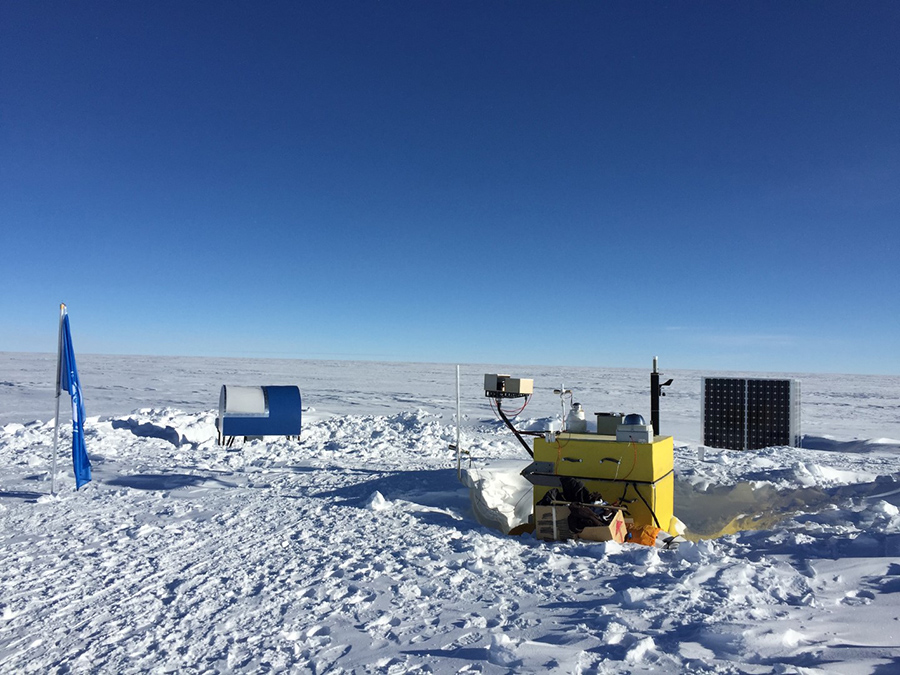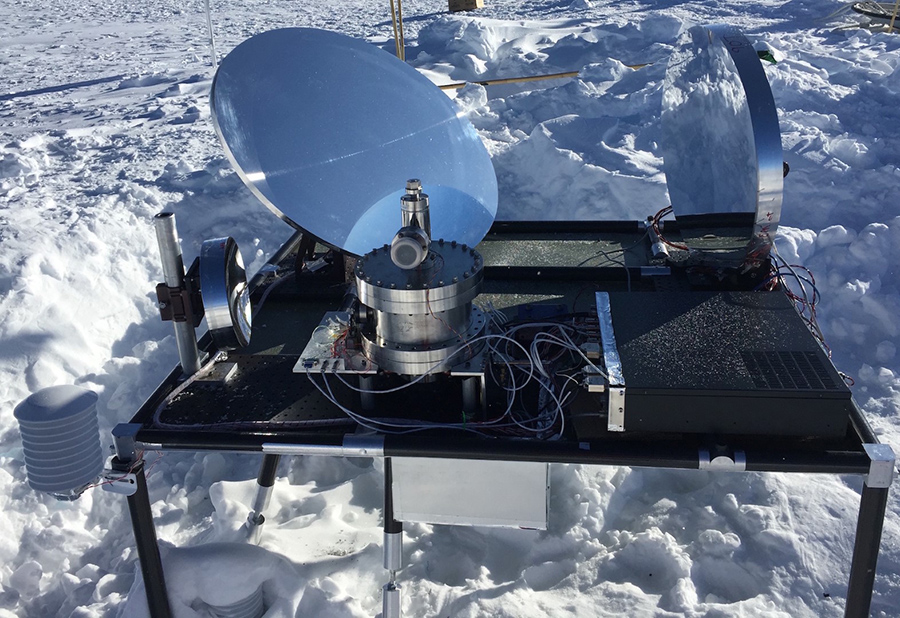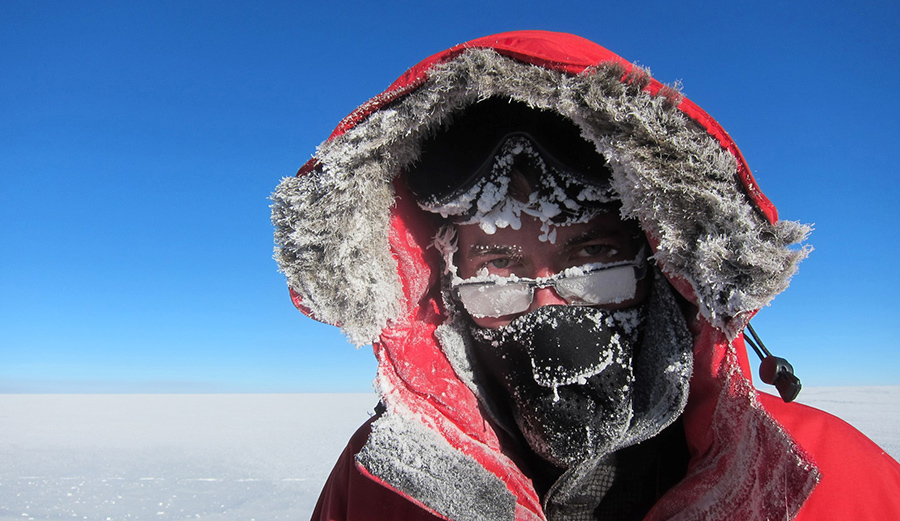The Stuff Between the StarsResearchers brave one of the harshest spots on Earth to learn how we’re all made of star stuffPosted April 4, 2016
In the middle of the high Antarctic plateau, more than 500 miles from the South Pole, a small telescope is meticulously studying the clear polar skies. 
Photo Credit: Craig Kulesa
Looking like the top of a small, blue mailbox, the covering surrounding the HEAT Telescope is designed to prevent snow from drifting on top of it. Next to it, the Australian-made yellow PLATO-R module is keeps power and communication flowing to the telescope.
It’s located at Ridge A, one of the most inhospitable places on the planet. Situated more than 13,000 feet above sea level, the site gets less precipitation than almost anywhere in the world. During the brief summer there, temperatures rarely rise above minus 30 Fahrenheit, while in winter they frequently drop down well past 100 below. “It’s cold and it has basically half the oxygen, half the atmospheric pressure, that you’re used to at sea level,” said Craig Kulesa, an astronomer at the University of Arizona. “It’s a challenging environment for a lot of reasons.” However, harsh conditions make it one of the best places on Earth to study the cosmos. Four years ago, scientists set up the High Elevation Antarctic Terahertz (HEAT) telescope to take advantage of the spot’s unique atmospheric conditions. The project is supported by the National Science Foundation, which manages the U.S. Antarctic Program. The scientific instrument was developed at the University of Arizona and the power and communications unit was contributed by Australia’s University of New South Wales. Kulesa is the principal investigator for the project. The table-sized, mailbox-shaped instrument is observing the interstellar medium, diffuse clouds of dust and gas that pervade throughout space. Kulesa and graduate student David Lesser endure sub-zero temperatures on annual maintenance trips because Ridge A is the only place on the planet to capture the faint signals emitted by these astronomical clouds. 
Photo Credit: Craig Kulesa
The HEAT Telescope unsheathed. Inside, three mirrors focus incoming Terahertz light onto a detector with a cryostat that operates at minus 370 degrees Fahrenheit.
“It’s as close as you can get to going into space with your feet still on the ground,” Kulesa said. Though space is a vacuum, it’s not completely empty. There are trace amounts of dust and gas throughout the cosmos in the space between stars. Most of this material is made up of the remnants of extinct stars that have burned away. This dust and gas coalesces into vast clouds, which can drift together and eventually condense into a new generation of stars and planets. “What we really want to understand is that full life cycle,” Kulesa said. “No one has ever seen a cloud form. No one really understands what it takes to cook up one of these clouds. And yet, every star and planet, including our own Sun and Earth formed from them.” These clouds are made up mostly of hydrogen and helium, the two most abundant elements in the universe, but that’s not what the telescope is looking at. Instead, it’s looking at the light released by carbon mixed inside the clouds and particularly around their edges. Every kind of atom emits and absorbs light at a unique characteristic frequency, and the project’s astronomers are tuned to carbon because it’s the easiest to see. “Hydrogen and helium don’t like to emit in ways that are useful for us. So the idea is that we look for these bright tracers that indicate the presence of these otherwise hard to measure things,” said David Lesser, a graduate student at the University of Arizona. The signals the team is looking for are in the terahertz range of the electromagnetic spectrum, long wavelengths of light that fall between the infrared and radio bands. They’re essentially or 1000 times redder than the reddest red that the human eye can see. “You can think of it as very very high frequency radio waves that are naturally generated by these clouds of dust and gas that you find all over the universe,” Lesser said. “We’re particularly interested in these closer ones in the Milky Way galaxy.” The telescope is located at Ridge A because moisture in the air makes it nearly impossible to observe these particular wavelengths of light from almost anywhere else on Earth. 
Photo Credit: Nic Bingham
Researchers unload their equipment and supplies from their Twin Otter airplane in 2014.
Water vapor is opaque to light waves at terahertz frequencies. Astronomers measure how much moisture is suspended between Earth and space in millimeters of “precipitable water vapor” (PWV). It’s essentially as if all the water vapor in the column of air overhead were converted into liquid, how deep that pool of water would be. A humid day in Washington DC might have as much as 50 millimeters of PWV. On a really dry day, there might be as little as a millimeter of PWV above Chile’s Atacama Desert or the top of Hawaii’s Mauna Kea, each home to some of the world’s most powerful telescopes. However this is still enough to completely blot out the Sun, making astronomy out of the question. During the middle of winter at Ridge A, there can be as little as a twentieth of a millimeter of PWV. “The best way to get dry, water-free air is just to refrigerate it. Air at minus 50 Celsius holds about one hundredth of the water vapor as air at 0 Celsius, at freezing,” Kulesa said. “The air can be saturated… the air can be holding all of the water it can possibly hold, and it is still drier than the best mid-latitude sites.” With so little water vapor in the air, signals that are normally blocked shine through. “What is a difficult observation at a mid-latitudes site is easy for us, and an impossible observation for them becomes merely challenging for us,” Kulesa said. 
Photo Credit: Anna Zajicek
Ice forms around the face of Nic Bingham, a researcher who worked at the site in 2014. Even in the peak of summer, temperatures rarely exceed minus 30 degrees Fahrenheit.
The cold, dry conditions that make the site ideal for astronomy also make working there a challenge. While Kulesa and Lesser were at the site during the peak of summer, the temperature hovered around minus 30 to minus 40 degrees Fahrenheit. “There's no other way to say it: working at Ridge A is hard. Really hard,” Kulesa said. “The high altitude and extreme cold, combined with the work hazards we bring (heavy lifting, extremely cold fuel, high voltage, delicate parts) make even simple tasks difficult. If you don't know your physical and mental limitations, you will definitely discover them at Ridge A.” For Kulesa and Lesser, this most recent trip to the site was a particularly difficult. In past years, they’d only been out for up to four days with a team of half a dozen technicians and support staff. This season it was just the two of them and one mountaineer to run the camp. “We ended up staying at Ridge A for eight days and seven nights. This was more time there than my other two trips combined,” Lesser said. “You have to pace yourself more, you have to work sustainably.” Adding to the strain, the instrument itself needed more repairs and adjustments than in previous years. The project is designed so that the whole telescope assembly can be swapped out and replaced with a duplicate because working in in the field is so difficult. Even so, unexpected problems inevitably crop up during the team’s servicing mission in the field. This year the team had to deal with a range of issues from a short-circuiting power supply to a failed voltage regulator with no replacement part. “It seemed like an unwelcome surprise popped up at every corner, but we kept knocking down the challenges one at a time until eventually we had the system fully up and running,” Kulesa said. “I don't think we could have done much better given circumstances.” All the work payed off and the telescope is up and running, taking measurements in the 1.5 TeraHertz range, about 1500 times higher than the operating frequency of a mobile phone. In addition the team returned with the stored data the telescope collected over the last year. “Right now we are processing all of the 2015 data that we physically returned from Ridge A in January. So far it looks simply amazing,” Kulesa said. The telescope that’s out there now is not only gathering valuable scientific data, it’s also a proof of concept. The team is hoping that after a few successful seasons, they can expand the instrument’s capabilities by installing multiple reproductions of it around the ridge. Through a technique called astronomical interferometry, many small telescopes can combine to become as powerful as a much larger telescope. “[You] just make multiple versions of HEAT set it around on the ice,” said Chris Walker, a scientist at the University of Arizona and co-principal investigator of the project. “Then you combine the signals that are collected from each of these little telescopes, and you can synthetically in the computer create a larger telescope by adding the light that’s gathered by these little telescopes and fake out having a larger telescope.” They’re already working on a proposal to build a small prototype of two or three telescopes around Ridge A. In addition, they’re hoping to upgrade the receiver to make it even more sensitive. “Every year we try to push what robotic systems can do,” Kulesa said. “It’s a fun thing doing what people say is impossible.” NSF-funded research in this story: Craig Kulesa, University of Arizona, Award No. 1410896 |



For USAP Participants |
For The Public |
For Researchers and EducatorsContact UsU.S. National Science FoundationOffice of Polar Programs Geosciences Directorate 2415 Eisenhower Avenue, Suite W7100 Alexandria, VA 22314 Sign up for the NSF Office of Polar Programs newsletter and events. Feedback Form |


